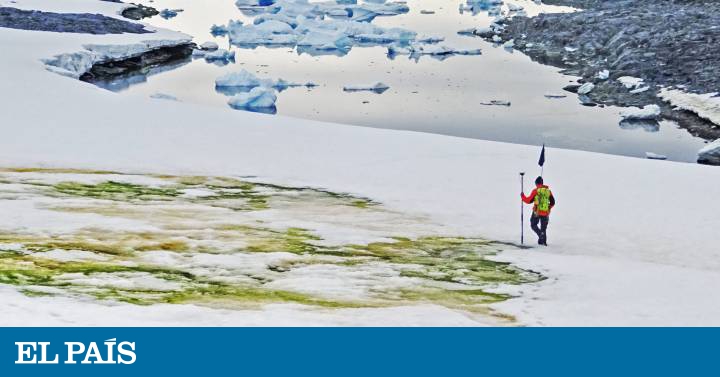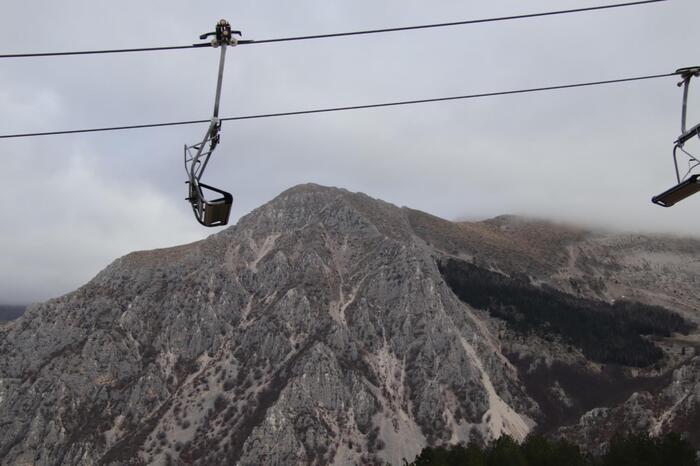"Green snow" is a phenomenon that - confirmed to me by Spanish polar scientists - also exists on the islands where the Spanish scientific bases are located, although it did not coincide for me to see it when I was there in February. The phenomenon, generated by microalgae that have been known since the fifties of the last century, will change the appearance of some places on this continent, at the mercy of climate change, and could extend further south than where it previously had its domains, according to the results of a British investigation, published in the journal Nature Communications.
The point is that these algae, which proliferate on what is known as "spring snow", that is, with temperatures above 0ºC, not only change the color of the snow, but, due to their presence, the area covered It could absorb more sunlight, generating more thaw. They also have an important role in the capture of CO2, through photosynthesis, not very important in quantity but in relation to that produced throughout the Antarctic.
"Terrestrial plant ecosystems in Antarctica are very limited. You probably saw a lot of moss and lichen on your recent trip, but they grow slowly as these algae flourish every southern summer, producing a large amount of new biomass. So far only We have data from satellites of three years and it is little time to know if they are already spreading, "Andrew Gray, from Cambridge University, first signatory of this work, explains to me via email. On the future that panorama is already looming, his colleague Matt Davey adds: "This work is a significant advance in our understanding of terrestrial life in Antarctica and how it could change in the coming years as the climate warms."
The research, involving scientists from this university and the British Antarctic Survey, is based both on data collected on the ground from expeditions to the Antarctic Peninsula and on images from the Sentinel 2 satellite of the European Space Agency. In total, they have identified 1,679 green algae blooms on snow, covering an area of 1.9 square kilometers, equivalent to a carbon sink of about 479 tons per year. It is little, but Davey remembers that it is very significant on a peninsula where all the vegetation barely covers 8.5 square kilometers.
It should also be borne in mind that the Sentinel 2 images have limitations: its instruments identify chlorophyll, that is, the color green, but not other colors, so other red algae have not been included in the work. or orange, the same ones that this year saw Ukrainian scientists proliferate at the Vernadsky Base, also in the Antarctic Peninsula. "I am now using higher resolution images over smaller areas to include these red algae in the biomass estimate," says Gray.
The snow around the #Antarctica coastline is turning green - and it's visible from space!
Researchers combined European Space Agency @esa satellite images with their own measurements on the icy continent to find out what's going on. # SustainableEarth pic.twitter.com/8Fixcajvka
On the other hand, he points out that there is a problem of scale difference: "With Sentinel 2 we can only identify large areas of flowering, while on the ground we saw many small green patches that the satellite cannot see," he says. This means that the coverage area that you estimate in your article is probably much smaller than it actually is, to which are added the ones that are red.
In any case, it is not only necessary that there be temperatures above 0 ºC for them to proliferate. Gray and his team have discovered that the proximity of colonies of marine fauna is important, because they are a source of nutrients, such as nitrogen or phosphorous, for these blooms. In fact, 60% of the green snow areas were no more than five kilometers from penguin colonies. Therefore, they explain, they will also affect the movements of that fauna, although other studies indicate that it could also move south if getting food becomes more difficult due to the increase in temperatures.
On whether any changes have been observed in these six years, the scientist comments: "It is still difficult to answer since each satellite image is a snapshot of an entire growing season and the Peninsula is usually very cloudy in summer. My observations indicate that the blooms are very influenced by the summer climate, so two years that I went down to Antarctica it snowed and rained a lot and the flowers were not big, but then in 2017 and 2020 they were very large. "
Almost two thirds of the snow green algae were found in the South Shetland Islands (King Jorge and Adelaide), not far from Livingston Island, home of one of the Spanish bases, the BAE Juan Carlos I. In 2016 and at Another Briton, Andy Hodson, of Shef fi eld University, studied there. In general, they are found between latitudes 62.3 ° and 68.1 ° South, where average air temperatures in summer are 0 ºC or more. Incidentally, they also require areas that are flat or gently sloping to thrive.
In the future they plan to check how the presence of such colorful, green or red shapes are affecting the quality of the albedo, that is, the percentage of radiation from the sun that reflects the snow. "I think we will have more flowers than the big ones in the future. But before we can draw conclusions, we need to do more calculations," Gray acknowledges.
More heat, more algae?
Gray does not rule out the possibility that one day large expanses of Antarctica will turn green if the forecasts for global warming and its impact on Antarctica are met: "It depends on the availability of nutrients that are higher up. High and average summer temperatures remain above freezing, so yes. Our images already show blooms at higher altitudes in the South Shetland Islands and I suspect this may be the case further south on the Peninsula, "he says.
The Spanish biologist Leopoldo García-Calvo, an expert in polar vegetation and one of whose works is mentioned in this British article, recalls that Livingston Island has also often seen these algal blooms. "Their total extension, from what the authors comment in the article, seems to be little, a little more than that of the Retiro and the Botanical Gardens of Madrid together, but they are of great scientific interest because of their significance as bioindicators of environmental changes. As long as summer temperatures above zero degrees converge on the Antarctic Peninsula and there is a supply of nutrients from coastal fauna colonies, these communities will spread, "he concludes.
Read more blogging topics and follow us on Flipboard.








/cloudfront-eu-central-1.images.arcpublishing.com/prisa/2C5HI6YHNFHDLJSBNWHOIAS2AE.jpeg)




